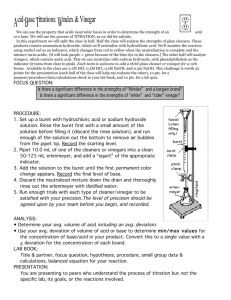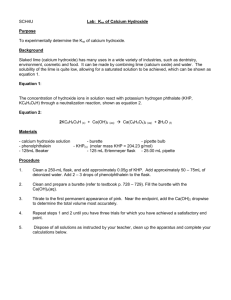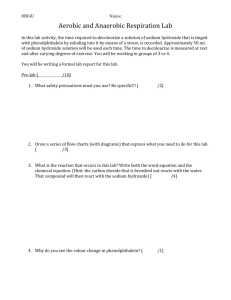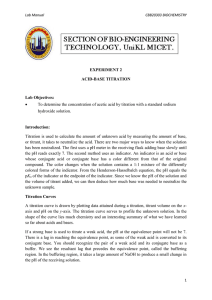CHM201 General Chemistry I and Laboratory
advertisement
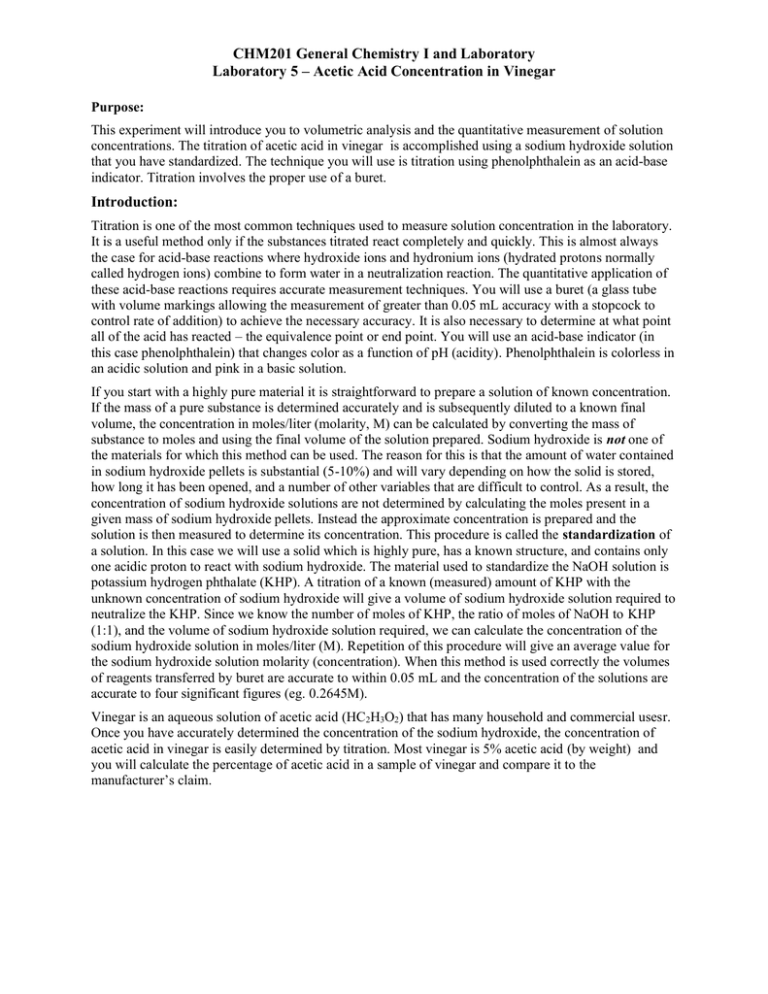
CHM201 General Chemistry I and Laboratory Laboratory 5 – Acetic Acid Concentration in Vinegar Purpose: This experiment will introduce you to volumetric analysis and the quantitative measurement of solution concentrations. The titration of acetic acid in vinegar is accomplished using a sodium hydroxide solution that you have standardized. The technique you will use is titration using phenolphthalein as an acid-base indicator. Titration involves the proper use of a buret. Introduction: Titration is one of the most common techniques used to measure solution concentration in the laboratory. It is a useful method only if the substances titrated react completely and quickly. This is almost always the case for acid-base reactions where hydroxide ions and hydronium ions (hydrated protons normally called hydrogen ions) combine to form water in a neutralization reaction. The quantitative application of these acid-base reactions requires accurate measurement techniques. You will use a buret (a glass tube with volume markings allowing the measurement of greater than 0.05 mL accuracy with a stopcock to control rate of addition) to achieve the necessary accuracy. It is also necessary to determine at what point all of the acid has reacted – the equivalence point or end point. You will use an acid-base indicator (in this case phenolphthalein) that changes color as a function of pH (acidity). Phenolphthalein is colorless in an acidic solution and pink in a basic solution. If you start with a highly pure material it is straightforward to prepare a solution of known concentration. If the mass of a pure substance is determined accurately and is subsequently diluted to a known final volume, the concentration in moles/liter (molarity, M) can be calculated by converting the mass of substance to moles and using the final volume of the solution prepared. Sodium hydroxide is not one of the materials for which this method can be used. The reason for this is that the amount of water contained in sodium hydroxide pellets is substantial (5-10%) and will vary depending on how the solid is stored, how long it has been opened, and a number of other variables that are difficult to control. As a result, the concentration of sodium hydroxide solutions are not determined by calculating the moles present in a given mass of sodium hydroxide pellets. Instead the approximate concentration is prepared and the solution is then measured to determine its concentration. This procedure is called the standardization of a solution. In this case we will use a solid which is highly pure, has a known structure, and contains only one acidic proton to react with sodium hydroxide. The material used to standardize the NaOH solution is potassium hydrogen phthalate (KHP). A titration of a known (measured) amount of KHP with the unknown concentration of sodium hydroxide will give a volume of sodium hydroxide solution required to neutralize the KHP. Since we know the number of moles of KHP, the ratio of moles of NaOH to KHP (1:1), and the volume of sodium hydroxide solution required, we can calculate the concentration of the sodium hydroxide solution in moles/liter (M). Repetition of this procedure will give an average value for the sodium hydroxide solution molarity (concentration). When this method is used correctly the volumes of reagents transferred by buret are accurate to within 0.05 mL and the concentration of the solutions are accurate to four significant figures (eg. 0.2645M). Vinegar is an aqueous solution of acetic acid (HC2H3O2) that has many household and commercial usesr. Once you have accurately determined the concentration of the sodium hydroxide, the concentration of acetic acid in vinegar is easily determined by titration. Most vinegar is 5% acetic acid (by weight) and you will calculate the percentage of acetic acid in a sample of vinegar and compare it to the manufacturer’s claim. Procedure: NOTE: Keep a large beaker at your station for waste disposal. This will prevent frequent trips to the waste containers at the instructor’s desk. 1. Standardization of Sodium Hydroxide Solution. WARNING: Sodium hydroxide can cause chemical burns!! Clean up any spilled sodium hydroxide and use care when working with the sodium hydroxide solution. A slippery or slimy feel on your skin is an indication that you have come into contact with sodium hydroxide. Alert the instructor and rinse the affected area completely with water. Gloves are available for student use, but can prevent you from detecting a spill. If you use gloves, you must rinse them frequently and avoid touching your face and clothing. Loose-fitting gloves are not allowed. 1.1 Prior to performing step 1.2, consult me to inspect your buret and ringstand. If a faulty setup causes problems in the lab, points will be deducted from your grade. 1.2 Obtain some sodium hydroxide solution in a small beaker and wash the buret with 5-10 mL of solution three times (be careful handling the sodium hydroxide solution!). Wash the buret by adding NaOH solution and allowing a small amount of it to pass through the stopcock (valve) at the bottom of the buret into your waste beaker. Then invert the buret into the waste beaker. 1.3 Fill the buret to just below the highest volumetric mark (that mark should be zero) and place the buret into the buret clamp. Read and record as Vo using appropriate units. You should be able to read the buret to within 0.05 mL (two decimal places). Be sure to record the reading where the meniscus (lowest point in the liquid column) meets the markings on the buret. You are not reading the volume of solution in the buret. You are reading the volume of the buret that is NOT filled. Absolutely no subtraction is required to get this reading. If you are unclear about this concept, do not proceed without further help. 1.4 Weigh out approximately 1.0 g (but at least 1.0 g) of potassium hydrogen phthalate (KHP) on an analytical balance and record the mass to within 0.1 mg (0.0001 grams). Transfer the KHP to a 250 mL erlenmeyer flask containing a magnetic stir bar (rinse flask and stir bar with distilled water before transferring the KHP). Record your measurement to the maximum number of significant figures indicated by the balance. 1.5 Add approximately 50 mL of distilled water to the flask and add 2-3 drops of phenolphthalein solution to the flask. Wash any solid KHP or phenolphthalein solution on the sides of the flask with a small quantity of distilled water from a wash bottle. 1.6 Start the magnetic stir bar in the flask with the buret tip inside the neck of the erlenmeyer flask. Regulate the speed of the stirrer so that the solution in the flask is not splashing excessively. 1.7 Open the stopcock and allow the sodium hydroxide solution into the flask transferring 5 mL (or less) increments of solution at a time. Observe the color of the indicator and slow the rate of addition as the color of the indicator takes longer and longer time to fade. Use a wash bottle of distilled water to wash down the sides of the flask if neccessary. When your are close to the endpoint add the sodium hydroxide solution drop by drop. It should take only one drop to turn the solution from clear to light pink when your are at the end-point of the titration. Observe the solution carefully! 1.8 Record the reading from the buret to two decimal places at the endpoint as Vf. 1.9 Repeat the KHP standardization of the sodium hydroxide solution (1.3-1.8) until you have completed two successful titrations. Do not repeat steps 1.1 and 1.2. 1.10 Calculate the number of moles of KHP used and, from that, the sodium hydroxide solution concentration for each trial and determine the average value of the two sucessful trials. (Not performed in class.) 2. Determination of the Acetic Acid content of Vinegar. 2.1 Pipette 10.00 mL of vinegar into a 250 mL erlenmeyer flask. Be sure to record the volume of vinegar transferred in mL to two decimal places. Combine the vinegar with approximately 50 mL of distilled water and 2-3 drops of phenolphthalein indicator solution. Be sure to wash down any vinegar or indicator solution with distilled water from a wash bottle prior to titration. 2.2 Refill the buret with sodium hydroxide and record the reading as V0. 2.3 Open the stopcock to titrate the vinegar solution in the same manner used to titrate the KHP in the standardization procedure. Record the reading of sodium hydroxide solution in the buret at the endpoint as Vf. Remember it should only take 1 or 2 drops to change the color from colorless to light pink. Volumes must be recorded to 2 decimal places. 2.4 Repeat procedures (2.1-2.3) until you have two successful titrations for the acid concentration of the vinegar samples. 2.5 Calculate the concentration of acetic acid in vinegar in moles/liter (M) using the class average concentration of the NaOH solution. Record the average of the two successful measurements as the average concentration. (Not performed in class.) Chemical Reactions: 1. KHP Standardization HKC8H4O4 + NaOH NaKC8H4O4 + H2O (KHP) Note: KHP has a molar mass of 204.22 g/mole and only one acidic proton 2. Acetic acid content of vinegar HC2H3O2 + NaOH NaC2H3O2 + H2O (Acetic Acid) Note: Acetic Acid has a molar mass of 60.052 g/mole and only one acidic proton


